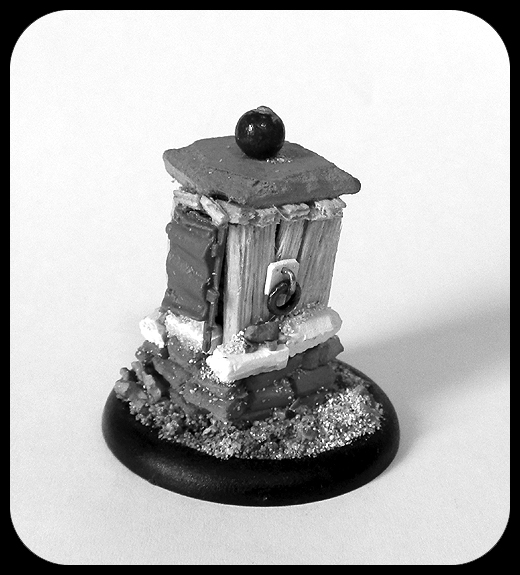Over at Wamp forum, a painting competition sponsored by Studio McVey has been announced a couple of weeks ago. Having actually bought one of their miniatures recently, I decided to enter the competition. Even if I hadn't already had the miniature, I would have used this chance to get one: the McVey store offers a 20% discount for anyone buying a mini for the contest. To get the discount just enter the code SMWAMP while buying at studiomcvey.com.
The miniature I painted was the lovely Ar-Fiach, from their limited edition resin range. It's a beautiful sculpt, and the resin miniature is tiny and delicate. I wanted it to be usable for my games- and to fit into the Gardens setting it needed some conversion. A TV aerial it holds on to and the too modern-looking chimney had to go. It's a pity in a way, because those bits really make it much more interesting. It is not often that you see a faerie depicted in an urban setting. Ah well... I might get another one some day.
The hand holding the aerial was replaced by one of the Hobbit Goblin hands. Something a tad smaller would have been perfect, but this was the best I had. The clawed hand reminds me a bit of bird talons, which is cool because Ar-Fiach sports a number of birdlike features to begin with: look at her legs from knees down, for example, and her hair is actually all feathers. I posed the hand as if she were saying to the observer: "Shhh. Don't scare away my prey." Quickly after the moment captured someone or something is going to get shot.
I also needed a replacement for the chimney. The most obvious option was to just build a more fantasy-looking chimney. However, I wanted her to stand much closer to the ground. It would have been cool if I could have put her on a small tree or a log. But the sculpt requires a very specific shape to stand on. After an afternoon of attempting to build some sort of small structure to fill the role, I ended up with this "hitching post + announcement board" thingy.
 |
| The base, completely built. This is a 40mm base, by the way. |
The metal rings on the sides look really nice and are fairly simple to make. You can get the little rings in hobby shops that sell jewellry-making materials. Then you simply cut a little square of plasticard and drill two holes in it. Attach the ring to it with a twice bent piece of paperclip or pin, and then glue the whole thing wherever you need it. This is also great for door knockers.
 |
| The painting on the base done. |
After adding some small stones and sand to to finish it off, I undercoated it grey and proceeded to the painting stage. Pale stone parts contrast the dark wood. I used pigments applied as a wash with water to add some colour to the grey dirt. The rusty effect on the metal rings was acheved by painting them first with a light reddish brown, followed by a bit darker brown pigment. It would have been better if I had a proper rust-coloured pigment; but alas, I don't.
 |
| The finished base. |
The final step was adding some foliage. Grass tufts, a couple of those tiny dry "leaves" I put on everything, and some moss patches on the stone bits. I actually darkened the grass a bit with a brown wash, and then lightly drybrushed the tips for contrast.
Oh, and the text on the message board was added in the meanwhile. It's just wavy lines, nothing intelligible.
 |
| Ready for painting. |
After that I started work on the miniature itself. I'm afraid I don't have any pictures of the painting process... The colour scheme was, as usual, pretty dark. I think that suits a faerie well, after all they are terrifying, morbid creatures. Those pretty blue and black striped feathers in her "hair" were inspired by jay feathers I usually wear on my hat. I think their vibrancy livens up the whole grim picture quite nicely.
 |
| Pretty little feathers... |
I haven't yet got a background story for this character, but a new faction is vaguely forming in my mind already. We'll see later what comes of it. : )
And as for the results of the McVey competition: the deadline is a whole month away, and after that who knows how long before the results come in. I'll have to be patient. I'm really looking forward to seeing the other entries.





























